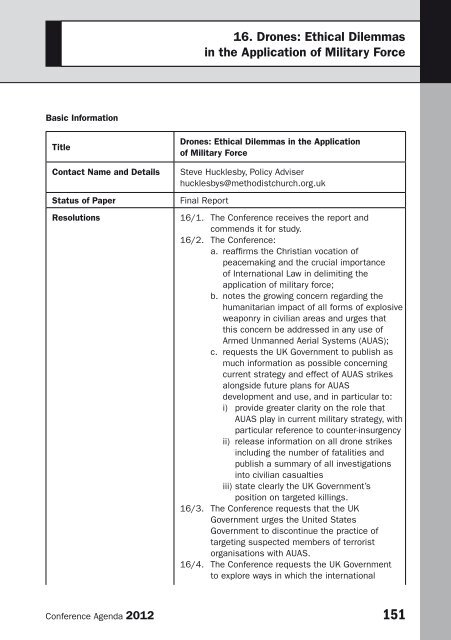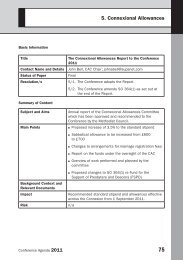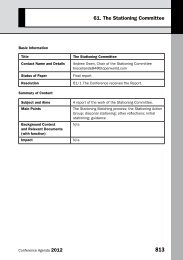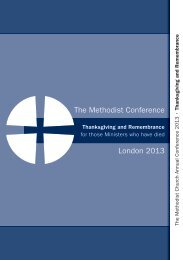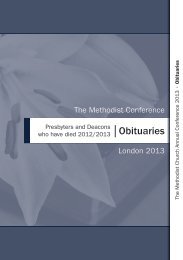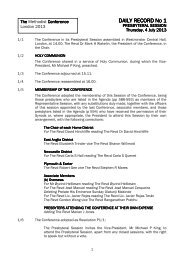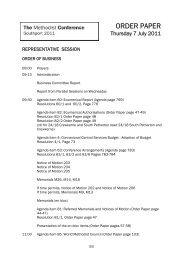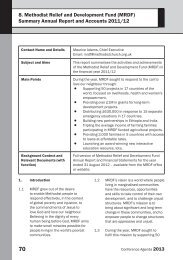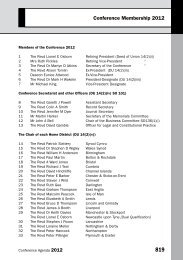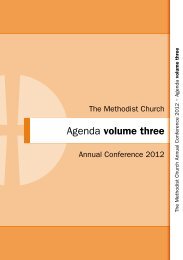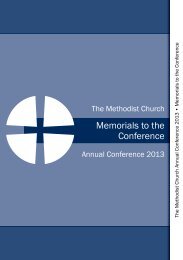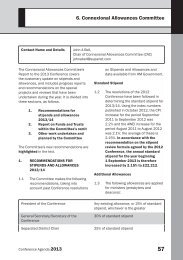16. Drones: Ethical Dilemmas in the Application of Military Force
16. Drones: Ethical Dilemmas in the Application of Military Force
16. Drones: Ethical Dilemmas in the Application of Military Force
You also want an ePaper? Increase the reach of your titles
YUMPU automatically turns print PDFs into web optimized ePapers that Google loves.
<strong>16.</strong> <strong>Drones</strong>: <strong>Ethical</strong> <strong>Dilemmas</strong><strong>in</strong> <strong>the</strong> <strong>Application</strong> <strong>of</strong> <strong>Military</strong> <strong>Force</strong>relatively small blast radius enables<strong>the</strong> operator to predict its impact toa high degree. It could justifiably beargued that this does not make <strong>the</strong>weapon any more valuable from <strong>the</strong>perspective <strong>of</strong> ethics – only moreuseable.6.5 There have been a number <strong>of</strong>tragic events when civilians havebeen mistaken for combatants andtargeted. It would appear that poorsituational awareness and faulty<strong>in</strong>telligence were key factors. TheUS Air <strong>Force</strong> has also acknowledgedthat operators have on occasionsplaced an undue confidence <strong>in</strong> <strong>the</strong>technology and consequently failedto ask crucial questions.6.6 There is a legal obligation formilitary forces to report on civiliandeaths. 22 ISAF <strong>in</strong>vestigation teamsdo not make public <strong>the</strong> reports<strong>of</strong> <strong>in</strong>vestigations <strong>in</strong>to <strong>in</strong>cidents <strong>of</strong>civilian deaths. UNAMA suggestthat prompt and public release <strong>of</strong><strong>in</strong>vestigation f<strong>in</strong>d<strong>in</strong>gs would promotetransparency, accountability andbetter relations with affected Afghancivilians and communities. 237.0 The AUAS Pilot7.1 It has been suggested that thosecharged with <strong>the</strong> control <strong>of</strong> AUASmight develop an unhealthyfamiliarity with kill<strong>in</strong>g by remotecontrol. A former UK fast jet pilotwho now ‘pilots’ a Reaper UAVdenies that because he is 12,000miles from <strong>the</strong> battlefield he will bedetached from impact <strong>of</strong> his actions.“We have <strong>the</strong> capability to see(unlike <strong>in</strong> a fast jet) <strong>the</strong> effect <strong>of</strong> ourweapon strikes <strong>in</strong> relatively closeupdetail. Also, if <strong>the</strong> troops on <strong>the</strong>ground take photos <strong>of</strong> <strong>the</strong> strikeeffects <strong>the</strong>y <strong>of</strong>ten send <strong>the</strong>m to usas feedback. No matter how explicit<strong>the</strong>se photos are I personally lookat <strong>the</strong>m all. Not because <strong>of</strong> somevoyeuristic tendency but because Ibelieve that if you cannot face <strong>the</strong>reality <strong>of</strong> what you do <strong>in</strong> kill<strong>in</strong>g ahuman be<strong>in</strong>g <strong>the</strong>n you should not bepart <strong>of</strong> that process.” 247.2 RAF operators <strong>of</strong> AUAS serve atCreech Air <strong>Force</strong> Base <strong>in</strong> Nevada<strong>in</strong>itially for three years and areexpected to live a strange doublelife. Whereas, <strong>the</strong>ir colleagues <strong>in</strong>manned aircraft are assigned to atour <strong>of</strong> duty and <strong>the</strong>n return homefor a period <strong>of</strong> recuperation, <strong>the</strong>AUAS operator will each day comb<strong>in</strong>e<strong>the</strong> horror <strong>of</strong> war with everydayfamily life. A British UAV pilot was<strong>in</strong>terviewed by Stephen Sackur fora BBC Radio 4 programme titled“Drone Wars”. He acknowledged<strong>the</strong> strangeness <strong>of</strong> be<strong>in</strong>g <strong>in</strong>volved <strong>in</strong>kill<strong>in</strong>g and <strong>the</strong>n go<strong>in</strong>g home to <strong>the</strong>22Breau, Pr<strong>of</strong> S, et al Discussion Paper 2: Drone attacks, <strong>in</strong>ternational law, and <strong>the</strong> record<strong>in</strong>g <strong>of</strong> civilian casualties<strong>of</strong> armed conflict; (Oxford Research Group, June 2011)23Afghanistan, 2011 Protection <strong>of</strong> Civilians <strong>in</strong> Armed Conflict (UNAMA, Kabul, Feb 2012)24Lee, P., ‘Remoteness, Risk and Aircrew Ethos’, <strong>in</strong> Air Power Review, Vol. 15, No. 1 (Spr<strong>in</strong>g 2012).Conference Agenda 2012 161
<strong>16.</strong> <strong>Drones</strong>: <strong>Ethical</strong> <strong>Dilemmas</strong><strong>in</strong> <strong>the</strong> <strong>Application</strong> <strong>of</strong> <strong>Military</strong> <strong>Force</strong>8.2 A crucial question concerns <strong>the</strong>circumstances under which wemight trust a mach<strong>in</strong>e to identifya target and fire a weapon withouthuman <strong>in</strong>tervention. There is agreat deal <strong>of</strong> research and ethicaldiscussion on this po<strong>in</strong>t. It canbe argued that un-distracted byemotions <strong>of</strong> vengeance or fear andcapable <strong>of</strong> process<strong>in</strong>g <strong>in</strong>formationfaster than humans, future robotweapons systems could displaymore consistent ethical behaviourthan <strong>the</strong>ir human counterparts.In a very different age August<strong>in</strong>e(reported by Aqu<strong>in</strong>as) acknowledged<strong>the</strong> dangers <strong>of</strong> such human fail<strong>in</strong>gs,“<strong>the</strong> passion for <strong>in</strong>flict<strong>in</strong>g harm,<strong>the</strong> cruel thirst for vengeance, anunpacific and relentless spirit, <strong>the</strong>fever <strong>of</strong> revolt, <strong>the</strong> lust <strong>of</strong> power, andsuchlike th<strong>in</strong>gs, all <strong>the</strong>se are rightlycondemned <strong>in</strong> war”. 27 But while<strong>the</strong> robots <strong>of</strong> <strong>the</strong> future might beable to demonstrate discretion, <strong>the</strong>capacity to show empathy or mercyis different altoge<strong>the</strong>r and maybe forthis reason as much as any o<strong>the</strong>r <strong>the</strong>autonomous operation <strong>of</strong> weaponssystems is a red l<strong>in</strong>e that should notbe crossed. On a more immediateand practical level we acknowledge<strong>the</strong> very difficult balance <strong>of</strong> risksand ethical judgements that weexpect our forces to make and <strong>the</strong>skill and expertise brought to thistask, sometimes under <strong>the</strong> mosttry<strong>in</strong>g circumstances. Thus <strong>the</strong>reis a broad consensus that for <strong>the</strong>foreseeable future authority t<strong>of</strong>ire a weapon must <strong>in</strong>volve human<strong>in</strong>teraction – <strong>the</strong> so-called ‘human <strong>in</strong><strong>the</strong> loop’.8.3 As systems become moreautomated <strong>the</strong> crucial questionis how <strong>the</strong> human <strong>in</strong> <strong>the</strong> loopperceives and executes <strong>the</strong>ir role.With an <strong>in</strong>creas<strong>in</strong>g amount <strong>of</strong>data available might <strong>the</strong> operatorsbecome swamped? If data ga<strong>the</strong>r<strong>in</strong>gbecomes more systematised withmore people <strong>in</strong>volved <strong>in</strong> <strong>the</strong> ‘killcha<strong>in</strong>’does <strong>the</strong> scope for <strong>in</strong>dividualquestion<strong>in</strong>g, for example concern<strong>in</strong>g<strong>the</strong> evidence that a person orobject is a legitimate military target,reduce? These are questions thatat this stage we raise as mattersfor fur<strong>the</strong>r study, aware that <strong>the</strong>y arealso be<strong>in</strong>g asked elsewhere.D. Conclusion9.0 Some Key Considerations9.1 Our approach has been to engagewith <strong>the</strong> reality that AUAS are hereto stay while rema<strong>in</strong><strong>in</strong>g committed tobiblical teach<strong>in</strong>g that ‘Peacemak<strong>in</strong>gis at <strong>the</strong> heart <strong>of</strong> <strong>the</strong> teach<strong>in</strong>g <strong>of</strong>Jesus, not an optional extra’. 28 Thetension that this creates is noteasily overcome. The conclusions27Thomas Aqu<strong>in</strong>as, Summa Theologia, II-II, q. 40, a. 1, c. Cit<strong>in</strong>g August<strong>in</strong>e, Contra Faustum, xxii, 74 (www.newadvent.org/summa/3.htm)28The Methodist Church and <strong>the</strong> United Reformed Church, Peacemak<strong>in</strong>g: A Christian Vocation (published Trusteesfor Methodist Church Purposes and <strong>the</strong> United Reformed Church, 2006), page 24.Conference Agenda 2012 163
<strong>16.</strong> <strong>Drones</strong>: <strong>Ethical</strong> <strong>Dilemmas</strong><strong>in</strong> <strong>the</strong> <strong>Application</strong> <strong>of</strong> <strong>Military</strong> <strong>Force</strong>recorded here are by no means af<strong>in</strong>al dest<strong>in</strong>ation – much more couldbe said. But for now we highlight <strong>the</strong>follow<strong>in</strong>g aspects:9.2 The seductive attraction <strong>of</strong> AUAS– The ease at which AUAS can bedeployed gives rise to real ethicalconcern. We must constantly projectour m<strong>in</strong>ds forward a decade or twoto a po<strong>in</strong>t when <strong>the</strong> technology andprecision weaponry are likely tohave proliferated with many moreStates as well as non-State actorsga<strong>in</strong><strong>in</strong>g access. Our nervousness<strong>in</strong> this respect is not helped byapparent uncerta<strong>in</strong>ties over howto apply national and <strong>in</strong>ternationallegal frameworks that have servedhi<strong>the</strong>rto to del<strong>in</strong>eate and limit <strong>the</strong>use <strong>of</strong> lethal force by <strong>the</strong> State.There exists a danger that <strong>the</strong>political ease with which <strong>the</strong>sesystems can be deployed, and <strong>the</strong>irfuture potential to deliver even moreprecise effect, might encourage<strong>the</strong> normalisation <strong>of</strong> <strong>the</strong> use <strong>of</strong>violence <strong>in</strong> response to crisis andconflict. We might beg<strong>in</strong> to addressthis by pay<strong>in</strong>g critical attention nowto <strong>the</strong> use <strong>of</strong> AUAS <strong>in</strong> <strong>the</strong> context<strong>of</strong> <strong>in</strong>surgency not<strong>in</strong>g that <strong>the</strong>irpersistent use <strong>in</strong> civilian areas tendsto <strong>in</strong>flame sentiment and underm<strong>in</strong>esupport for government.Given <strong>the</strong> potential for globalexpansion <strong>of</strong> <strong>the</strong> AUAS marketit is vital that churches and <strong>the</strong>irmembers are <strong>in</strong>formed and <strong>in</strong>volved<strong>in</strong> debate <strong>of</strong> <strong>the</strong>se issues.9.3 International law and targetedkill<strong>in</strong>gs – The UK’s position onterrorism 29 (and <strong>in</strong>deed that <strong>of</strong>almost all member states <strong>of</strong> <strong>the</strong>UN) is that <strong>the</strong> rules <strong>of</strong> armedconflict cannot be <strong>in</strong>voked aga<strong>in</strong>stterrorists outside <strong>of</strong> a situation <strong>of</strong>armed conflict. Our governmentis placed <strong>in</strong> a deeply ambiguousposition with respect to <strong>the</strong> US AUASattacks <strong>in</strong> nor<strong>the</strong>rn Pakistan andYemen. We work closely with <strong>the</strong>United States <strong>in</strong> <strong>the</strong> operation <strong>of</strong>AUAS. The US and UK are <strong>the</strong> twolargest contributors to ISAF forces <strong>in</strong>Afghanistan and cooperate closely <strong>in</strong><strong>in</strong>telligence operations <strong>in</strong> nor<strong>the</strong>rnPakistan. There is evidence that <strong>the</strong>US operations <strong>in</strong> nor<strong>the</strong>rn Pakistanencourage extremism and result <strong>in</strong><strong>in</strong>creased recruitment to terroristgroups. 30It is clearly <strong>in</strong> <strong>the</strong> <strong>in</strong>terest <strong>of</strong> justicethat those suspected <strong>of</strong> carry<strong>in</strong>g outor organis<strong>in</strong>g terrorism are brought toaccount. Never<strong>the</strong>less <strong>in</strong>ternationallaw has normative content thatrema<strong>in</strong>s important <strong>in</strong> safeguard<strong>in</strong>g<strong>the</strong> <strong>in</strong>ternational community from29 This understand<strong>in</strong>g was stipulated as a part <strong>of</strong> <strong>the</strong> UK’s acceptance <strong>of</strong> <strong>the</strong> 1977 Additional Protocol 1.O’Connell Seductive <strong>Drones</strong>: Learn<strong>in</strong>g from a decade <strong>of</strong> Lethal Operations.30 David Kilcullen & Andrew McDonald Exum, Death From Above, Outrage Down Below, NewYork Times, May17, 2009 and O’Connell, Mary Ellen, The Choice <strong>of</strong> Law Aga<strong>in</strong>st Terrorism, Journal Of National Security, Law& Policy, Vol. 4:34331 Afghanistan, 2011 Civilian Causalities Report (UNAMA, Kabul, Feb 2012)164 Conference Agenda 2012
<strong>16.</strong> <strong>Drones</strong>: <strong>Ethical</strong> <strong>Dilemmas</strong><strong>in</strong> <strong>the</strong> <strong>Application</strong> <strong>of</strong> <strong>Military</strong> <strong>Force</strong>descent <strong>in</strong>to arbitrar<strong>in</strong>ess and <strong>the</strong>uncontrolled use <strong>of</strong> brute force. Thetargeted kill<strong>in</strong>g <strong>of</strong> named <strong>in</strong>dividualsoutside <strong>the</strong> context <strong>of</strong> an armedconflict is a form <strong>of</strong> lawlessness thatimperils us all. It is <strong>in</strong> our nationalsecurity <strong>in</strong>terests to uphold <strong>the</strong> basicaccepted norms <strong>in</strong> <strong>in</strong>ternational lawand to work to ensure cohesion <strong>in</strong>approach among our <strong>in</strong>ternationalpartners.9.4 Accountability under law – Greateropenness and accountability on <strong>the</strong>part <strong>of</strong> military forces would help toclear some <strong>of</strong> <strong>the</strong> fog that surrounds<strong>the</strong> systems and <strong>the</strong>ir use. We havenoted <strong>the</strong> recommendation thatprompt and public release <strong>of</strong> ISAF<strong>in</strong>vestigations <strong>in</strong>to <strong>in</strong>cidents <strong>in</strong>volv<strong>in</strong>gcivilian casualties from all air strikes(by manned or unmanned aircraft)would improve relations with affectedAfghan civilians and communities. 31Greater transparency would also helpto resource public understand<strong>in</strong>g anddebate. Without public trust andaccountability fears may <strong>in</strong>creasethat ra<strong>the</strong>r than be<strong>in</strong>g masters <strong>of</strong>technology, <strong>the</strong> technology may cometo master us.***RESOLUTIONS16/1. The Conference receives <strong>the</strong> report and commends it for study.16/2. The Conference:a. reaffirms <strong>the</strong> Christian vocation <strong>of</strong> peacemak<strong>in</strong>g and <strong>the</strong> crucial importance<strong>of</strong> International Law <strong>in</strong> delimit<strong>in</strong>g <strong>the</strong> application <strong>of</strong> military force;b. notes <strong>the</strong> grow<strong>in</strong>g concern regard<strong>in</strong>g <strong>the</strong> humanitarian impact <strong>of</strong> all forms<strong>of</strong> explosive weaponry <strong>in</strong> civilian areas and urges that this concern beaddressed <strong>in</strong> any use <strong>of</strong> Armed Unmanned Aerial Systems (AUAS);c. requests <strong>the</strong> UK Government to publish as much <strong>in</strong>formation as possibleconcern<strong>in</strong>g current strategy and effect <strong>of</strong> AUAS strikes alongside futureplans for AUAS development and use, and <strong>in</strong> particular to:i) provide greater clarity on <strong>the</strong> role that AUAS play <strong>in</strong> current militarystrategy, with particular reference to counter-<strong>in</strong>surgencyii) release <strong>in</strong>formation on all drone strikes <strong>in</strong>clud<strong>in</strong>g <strong>the</strong> number <strong>of</strong> fatalitiesand publish a summary <strong>of</strong> all <strong>in</strong>vestigations <strong>in</strong>to civilian casualtiesiii) state clearly <strong>the</strong> UK Government’s position on targeted kill<strong>in</strong>gs.16/3. The Conference requests that <strong>the</strong> UK Government urges <strong>the</strong> United StatesGovernment to discont<strong>in</strong>ue <strong>the</strong> practice <strong>of</strong> target<strong>in</strong>g suspected members <strong>of</strong>terrorist organisations with AUAS.Conference Agenda 2012 165
<strong>16.</strong> <strong>Drones</strong>: <strong>Ethical</strong> <strong>Dilemmas</strong><strong>in</strong> <strong>the</strong> <strong>Application</strong> <strong>of</strong> <strong>Military</strong> <strong>Force</strong>16/4. The Conference requests <strong>the</strong> UK Government to explore ways <strong>in</strong> which <strong>the</strong><strong>in</strong>ternational community might implement an arms control regime to reduce <strong>the</strong>threat posed by <strong>the</strong> development <strong>of</strong> systems capable <strong>of</strong> autonomous target<strong>in</strong>gand weapons delivery.The Work<strong>in</strong>g GroupSteve Hucklesby - Policy Adviser, Jo<strong>in</strong>t Public Issues TeamDr Peter Lee - Senior Air Power Lecturer, Department for Defence Studies, K<strong>in</strong>gs CollegeLondon (and former RAF Chapla<strong>in</strong>)Paul Morrison - Policy Adviser, Jo<strong>in</strong>t Public Issues TeamDr Es<strong>the</strong>r Reed - Associate Pr<strong>of</strong>essor and Head <strong>of</strong> Theology and Religion, University <strong>of</strong>ExeterPaul Schulte - Senior Visit<strong>in</strong>g Fellow, Centre for Defence Studies, K<strong>in</strong>gs College LondonThe work<strong>in</strong>g group are grateful for <strong>the</strong> assistance provided by friends and colleaguesacross churches, academic <strong>in</strong>stitutions and <strong>in</strong> <strong>the</strong> armed forces <strong>in</strong> <strong>the</strong> preparation <strong>of</strong> thisreport.Disclaimer - It should not be assumed that all aspects <strong>of</strong> this report have <strong>the</strong> support <strong>of</strong>every member <strong>of</strong> <strong>the</strong> work<strong>in</strong>g group.166 Conference Agenda 2012


